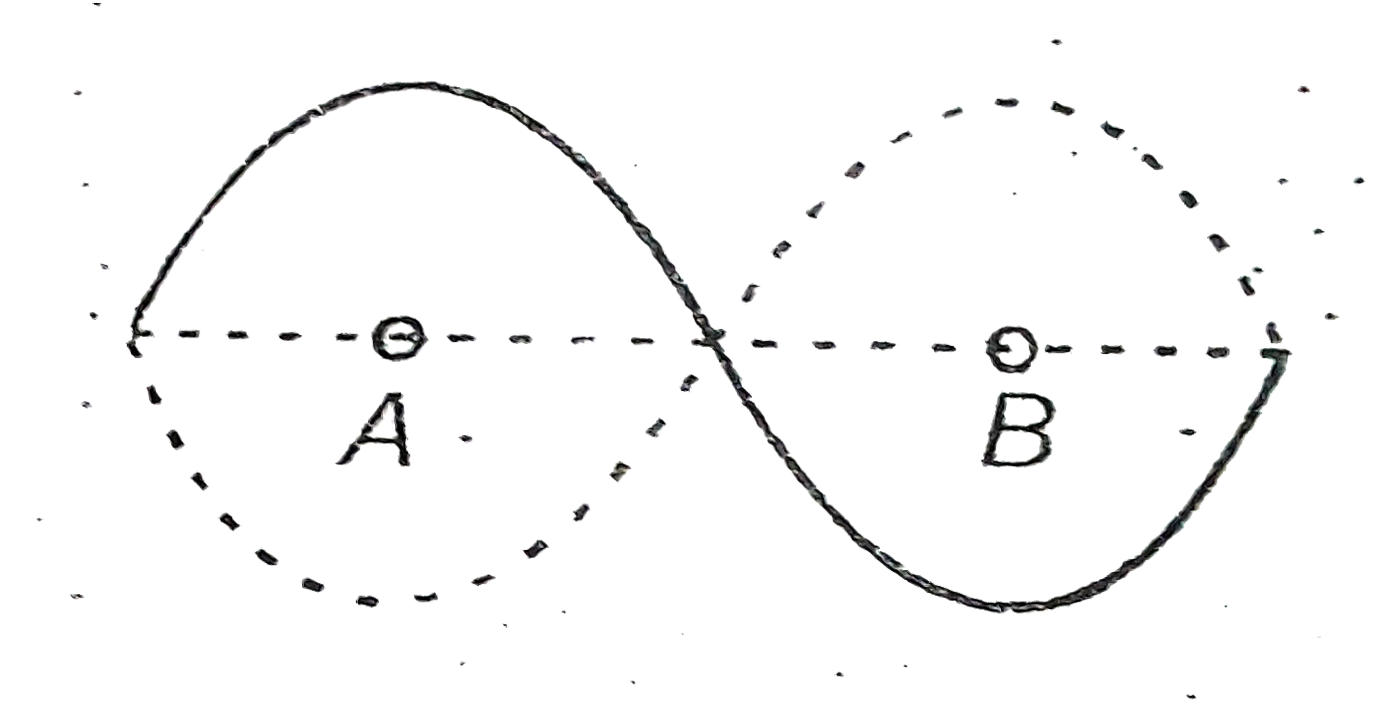When a train of plane wave traverses a medium, individual particles execute periodic motion given by the equation
y4sin(π)2(2tx8)
Where the length are expressed in centimetres and time in seconds. Calculate the amplitute, wavelength, (a) the phase different for two positions of the same particle which are occupied at time interval 0.4 s apart and (b) the phase difference at any given instant of two particle 12 cm apart.
To solve the given problem step by step, we will analyze the wave equation and calculate the required parameters.
Given Wave Equation:
The wave equation is given as:
y=4sin(π2(2t+x8))
Step 1: Identify the Amplitude
The amplitude A is the coefficient of the sine function in the wave equation.
Solution:
From the equation, we can see that:
A=4cm
Step 2: Identify the Wavelength
The general form of a wave equation is:
y=Asin(kx−ωt)
where k=2πλ and ω=2πf.
From our equation:
k=π2⋅8=π16
To find the wavelength λ:
k=2πλ⇒λ=2πk=2ππ16=32cm
Step 3: Calculate the Phase Difference for Two Positions of the Same Particle
Let’s denote the two time instances as t1 and t2 where t2=t1+0.4 seconds.
Solution:
The phase at time t1:
ϕ1=π2(2t1+x8)
The phase at time t2:
ϕ2=π2(2t2+x8)=π2(2(t1+0.4)+x8)
=π2(2t1+0.8+x8)
Now, the phase difference Δϕ:
Δϕ=ϕ2−ϕ1
=π2(0.8)=π2⋅0.8=0.4π2=0.2π
To convert this into degrees:
Δϕ=0.2π×180π=36∘
Step 4: Calculate the Phase Difference for Two Particles 12 cm Apart
Let’s denote the distance between the two particles as Δx=12cm.
Solution:
The phase difference Δϕ for two particles separated by a distance Δx is given by:
Δϕ=2πλΔx
Substituting the values:
Δϕ=2π32⋅12=24π32=3π4
Final Answers:
1. Amplitude A=4cm
2. Wavelength λ=32cm
3. (a) Phase difference for two positions of the same particle =36∘
4. (b) Phase difference for two particles 12 cm apart =3π4 radians or 135∘
The wave equation is given as:
y=4sin(π2(2t+x8))
The amplitude A is the coefficient of the sine function in the wave equation.
From the equation, we can see that:
A=4cm
The general form of a wave equation is:
y=Asin(kx−ωt)
where k=2πλ and ω=2πf.
k=π2⋅8=π16
k=2πλ⇒λ=2πk=2ππ16=32cm
Let’s denote the two time instances as t1 and t2 where t2=t1+0.4 seconds.
The phase at time t1:
ϕ1=π2(2t1+x8)
ϕ2=π2(2t2+x8)=π2(2(t1+0.4)+x8)
=π2(2t1+0.8+x8)
Δϕ=ϕ2−ϕ1
=π2(0.8)=π2⋅0.8=0.4π2=0.2π
Δϕ=0.2π×180π=36∘
Let’s denote the distance between the two particles as Δx=12cm.
The phase difference Δϕ for two particles separated by a distance Δx is given by:
Δϕ=2πλΔx
Substituting the values:
Δϕ=2π32⋅12=24π32=3π4
1. Amplitude A=4cm
2. Wavelength λ=32cm
3. (a) Phase difference for two positions of the same particle =36∘
4. (b) Phase difference for two particles 12 cm apart =3π4 radians or 135∘
Topper's Solved these Questions
- BOOK - CENGAGE PHYSICS ENGLISHCHAPTER - TRAVELLING WAVESEXERCISE - Exercise 5.19videos
TRAVELLING WAVES
- BOOK - CENGAGE PHYSICS ENGLISHCHAPTER - TRAVELLING WAVESEXERCISE - Exercise 5.223videos
TRAVELLING WAVES
- BOOK - CENGAGE PHYSICS ENGLISHCHAPTER - TRAVELLING WAVESEXERCISE - Integer9videos
TRAVELLING WAVES
- BOOK - CENGAGE PHYSICS ENGLISHCHAPTER - TRANSMISSION OF HEATEXERCISE - Single correct9videos
TRANSMISSION OF HEAT
- BOOK - CENGAGE PHYSICS ENGLISHCHAPTER - VECTORSEXERCISE - Exercise Multiple Correct5videos
VECTORS
Similar Questions
The equation of a wave is y=4sin{π2(2t+x8)} where y , x are in cm and time in seconds. The phase difference between two position of the same particle which are occupied at time interval of 0.4 s is xπ×10−1 , what is the value of x ?
View SolutionPosition-time relationship of a particle executing simple harmonic motion is given by equation
x=2sin(50πt+2π3) where x is in meters and time t is in seconds.
What is the position of particle at t=1s ?View Solution
Knowledge Check
- Question 1 - Select One
The displacement of a particle executing simple harmonic motion is given by
x=3sin(2πt+π4)
where x is in metres and t is in seconds. The amplitude and maximum speed of the particle isA3m, 2πms−1B3m, 4πms−1C3m, 6πms−1D3m, 8πms−1
The equation of progressive wave is given by y=10sin[300π(t−x480)]
where x and y are in metre and t is in second. Calculate the amplitude frequency time period and wavelength of the wave.View Solution(b) The displacement of a particle executing simple harmonic motion is given by the equation y=0.3sin20π(t+0.05) , where time t is in seconds and displacement y is in meter. Calculate the values of amplitude, time period, initial phase and initial displacement of the particle.
View SolutionPosition-time relationship of a particle executing simple harmonic motion is given by equation
x=2sin(50πt+2π3) where x is in meters and time t is in seconds.
What is the position of particle at t=0.5s ?View SolutionPosition-time relationship of a particle executing simple harmonic motion is given by equation
x=2sin(50πt+2π3) where x is in meters and time t is in seconds.
What is the position of particle at t=0 ?View SolutionA simple harmonic progressive wave is representive by the equation y=8sin2π(0.1x−2t) where x and y are in centimetres and t is in seconds. At any instant the phase difference between two particle separted by 2.0 cm along the x-direction is
View SolutionEquation of a transverse wave travelling in a rope is given by
y=5sin(4.0t−0.02x)
where y and x are expressed in cm and time in seconds. Calculate
(a) the amplitude, frequency,velocity and wavelength of the wave.
(b) the maximum transverse speed and acceleration of a particle in the rope.View SolutionIn a standing wave particles at the positions A and B, have a phase difference of
 View Solution
View Solution
